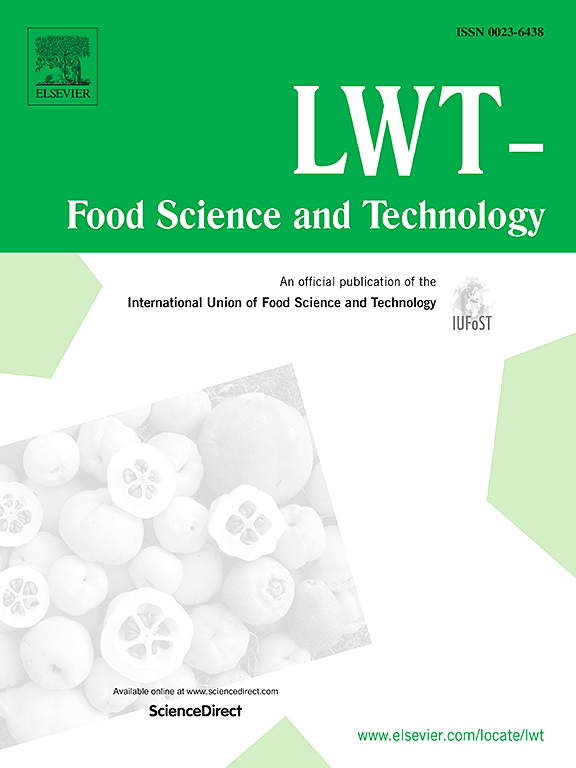Mixture design approach for the compositional optimization of cereal grain and legume toward improved biological activity
IF 6
1区 农林科学
Q1 FOOD SCIENCE & TECHNOLOGY
引用次数: 0
Abstract
Whole grain and legume are increasingly recommended as part of a healthy diet due to their beneficial properties. Blending these seeds can enhance their overall bioactivity. However, optimal mixing ratios remain to be determined. This study aimed to determine the optimal blend ratio of cereal grain and legume with enhanced biological activity using a mixture design approach. Three seed cultivars–sorghum (cv. Goeunchal), Italian millet (cv. Samdachal), and black soybean (cv. Soman)–were selected for their distinct compositional characteristics and potential lipase inhibitory activities. An optimal mixture was identified through response surface modeling, targeting maximized lipase inhibitory activity, along with improved antioxidant activity and extraction yield, and was validated by experimental confirmation. Compositional analyses revealed that Soman was rich in constituent amino acids and omega-3 fatty acids, Samdachal exhibited favorable lipid indices with low atherogenicity and thrombogenicity, and Goeunchal demonstrated superior protein efficiency and antioxidant potential. The optimized blend (64.415 % Goeunchal, 18.535 % Samdachal, and 17.050 % soman) exhibited a harmonized nutritional profile, with balanced amino acid composition and improved lipid quality. Compared to Samdachal, the optimized blend exhibited 26.39- and 1.45-fold higher DPPH radical scavenging and lipase inhibitory activities, respectively. These findings demonstrate that mixture design optimization can effectively integrate the complementary traits of individual seeds and produce a functionally enhanced seed blend with potential applications in health-promoting food applications.
谷物和豆科植物优化组合以提高生物活性的混合设计方法
全谷物和豆类由于其有益的特性,越来越多地被推荐为健康饮食的一部分。混合这些种子可以提高它们的整体生物活性。然而,最佳的混合比例仍有待确定。本研究旨在采用混合设计方法确定谷物和豆类的最佳混合比例,以提高生物活性。三种种子品种-高粱(cv;Goeunchal),意大利小米(谷子)。Samdachal)和黑豆(cv。由于其独特的组成特征和潜在的脂肪酶抑制活性而被选中。通过响应面建模,确定了以最大限度抑制脂肪酶活性、提高抗氧化活性和提取率为目标的最佳混合物,并通过实验验证了该混合物的有效性。成分分析表明,Soman富含氨基酸和omega-3脂肪酸,Samdachal具有良好的脂质指标,具有较低的动脉粥样硬化性和血栓形成性,Goeunchal具有优越的蛋白质效率和抗氧化潜力。优化后的混合饲料(64.415% Goeunchal, 18.535% Samdachal, 17.050% soman)营养成分一致,氨基酸组成平衡,脂质质量提高。与Samdachal相比,优化后的混合物对DPPH自由基的清除能力和抑制脂肪酶的活性分别提高了26.39倍和1.45倍。这些结果表明,混合设计优化可以有效地整合单个种子的互补特性,生产出功能增强的混合种子,在促进健康的食品中具有潜在的应用前景。
本文章由计算机程序翻译,如有差异,请以英文原文为准。
求助全文
约1分钟内获得全文
求助全文
来源期刊

LWT - Food Science and Technology
工程技术-食品科技
CiteScore
11.80
自引率
6.70%
发文量
1724
审稿时长
65 days
期刊介绍:
LWT - Food Science and Technology is an international journal that publishes innovative papers in the fields of food chemistry, biochemistry, microbiology, technology and nutrition. The work described should be innovative either in the approach or in the methods used. The significance of the results either for the science community or for the food industry must also be specified. Contributions written in English are welcomed in the form of review articles, short reviews, research papers, and research notes. Papers featuring animal trials and cell cultures are outside the scope of the journal and will not be considered for publication.
 求助内容:
求助内容: 应助结果提醒方式:
应助结果提醒方式:


